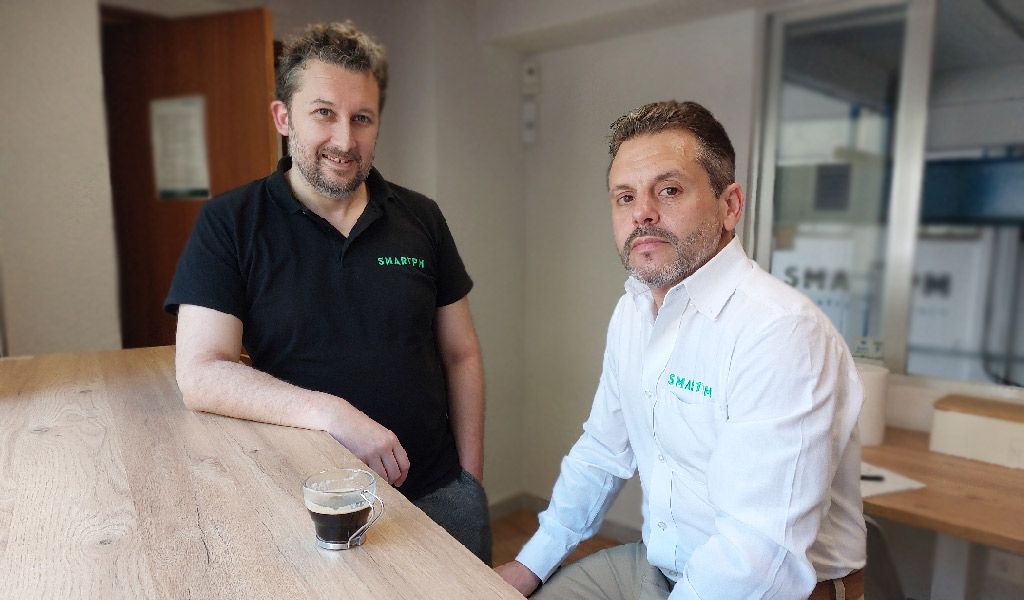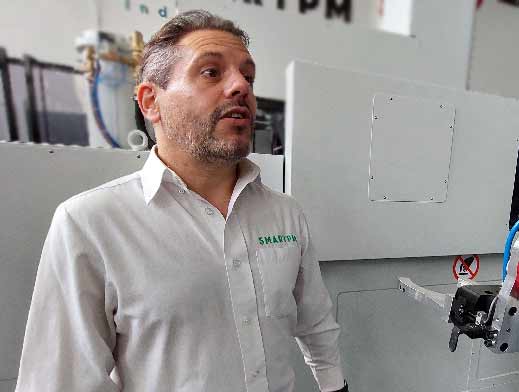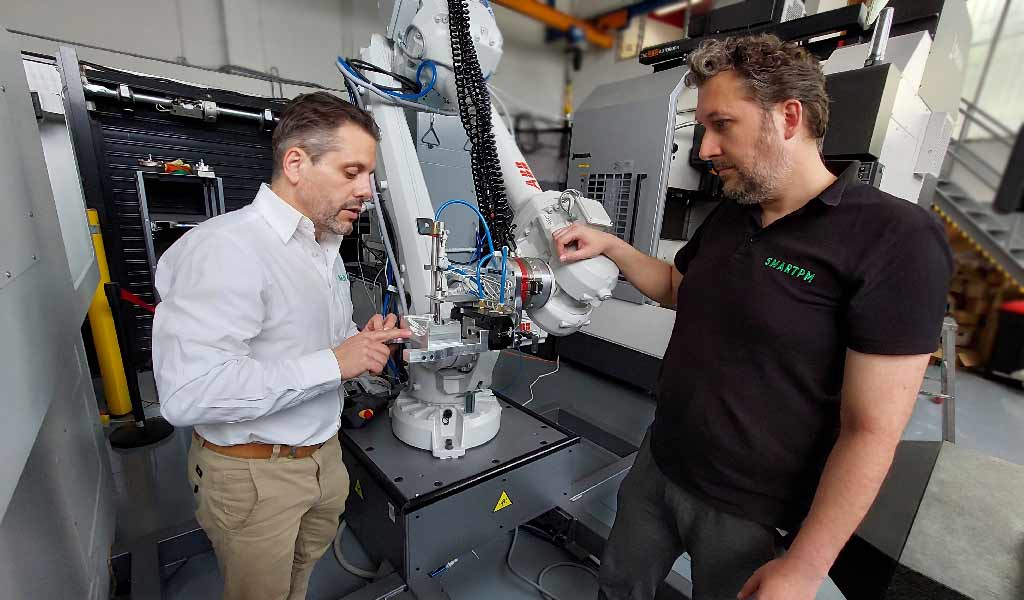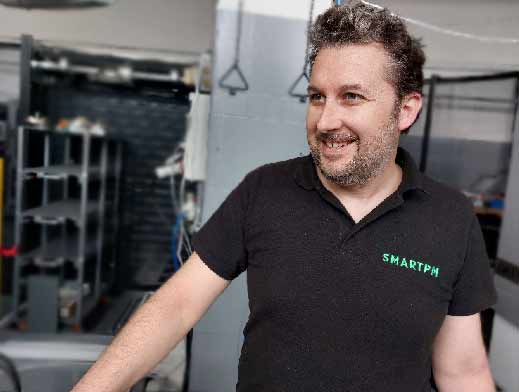In this article we go out of our usual line to solve some doubts that arise when choosing industrial software. What do I need? What is the most suitable production software today? Where is the market going?
For this purpose we met with our colleagues Jon Albuerne and Xabier Garaloces, SMARTPM Key Account Managers for Hexagon's production software distribution division.

Jon knows firsthand what it's like to be "in the mud" of machining. As an applications technician, he has known different customers, sectors, machines and problems all over the world. He has been in the world of machining and CAM since 2006 and has been a technician for machine manufacturers (national as Goratu/Geminis and international as Makino) and software manufacturers (as Pixel Sistemas/Siemens).
Xabier has 20 years of experience in the industrial software sector, 14 of them in the industrial production software sector. This industrial engineer knows multitasking machines like no one else.
In addition to having a cup of coffee, we talked to both specialists to learn about their vision of industrial software from their experience in the machine tool sector.
The industrial software market
What is the state of the industrial software market?
Xabier: The market is becoming increasingly globalized, which requires being more productive and competitive. This is leading to more complex and automated machines that require software with greater capacity to manage them.
The trend is toward integrated manufacturing, where everything is connected. And for that we have software and technology.
Does this trend affect both large industrial companies and small workshops?
X: That's right, and demand is changing: production runs are now getting shorter and shorter, which makes long-term forecasting more difficult. Many customers now order small batches several times instead of a single large batch all at once. In other words, shorter runs with more customization, forcing shops to be more productive to offset manufacturing costs and thus remain competitive.
How can a small machining shop compete in a scenario like this? What does the software bring to them?
Jon: Any workshop looks for the technology that has the lowest cost and that can provide the most benefit, that is the importance of software. For example, a machine can cost 200,000€ while the software can cost 10 times less, but the benefit it provides is much higher.
Likewise, making the wrong software choice can have important consequences, so making the right software decision is a strategic issue.
The decision to purchase production software
When a company considers acquiring production software, what are its options? One of the questions to decide may be whether to buy a new software to migrate everything to or to keep stacking different software as needed. Which is preferable?
X: The trend is toward integrated manufacturing, where the challenge is productivity and total quality. To achieve that you have to take into account all the phases involved in the manufacturing process, and in all of them there is software, technology, data, etc. Ideally, everything should be connected from start to finish: from the supply to the output of the product.
You have to think that when you buy software, you are not only buying the technology, but you are buying a commitment of years with a supplier. That is an important decision.
Any advice? It occurs to me that some technologies may be more future-proof and therefore pose less risk in committing to them.
J: Yes, right now the decision is clear. We are in a Big Data boom and manufacturing and measuring machines are handling more and more data. The logical decision is to go towards technologies that can encompass the entire manufacturing process, that allow all parts to "talk" to each other.
Any workshop looks for the technology that has the lowest cost and can provide the most benefit, that is the importance of the software.
Therefore, I advise going for companies that offer global solutions: metrology, reverse engineering, product lifecycle, part programming... and that all of them have the ability to communicate with each other.
It no longer makes sense to use paper, to pass data by hand to a machine. That human factor should be dedicated to other tasks that really add value, leaving the technology to take care of those issues.
Then, there is software that integrates all the manufacturing of a workshop, even being different pieces, different machinery...
X: Exactly. There are large corporations like Hexagon that offer integrated manufacturing solutions because they are made up of many companies that offer specific solutions for each process, but are interconnected among them.

Imagine this case: a die breaks in a stamping shop and the part is brought to you for you to manufacture a replacement... Ideally, the scanner with which you obtain the model, the CAM software, the measuring and verification machine... are all interconnected so that you can machine that part in the shortest possible time and in compliance with standards. That's what allows you to offer competitive prices and much shorter lead times than the competition.
Imagine this case: a die breaks in a stamping shop and the part is brought to you so that you can manufacture a replacement. Ideally, the scanner with which you obtain the model, the CAM software, the measuring and verification machine... everything is interconnected so that you can machine the part in the shortest possible time and in compliance with standards. That's what allows you to offer competitive prices and much shorter lead times than the competition.
Something else has also happened, and that is that the pandemic has made us reflect on our dependence on the human factor. We need the human factor, of course, but in tasks that add value, not to move parts from one place to another. Interconnecting the entire process allows us to reduce the human intervention necessary for production, while operators are engaged in improvement tasks that allow them to be more productive.
Industrial software suppliers
How are software vendors responding in this context?
Jon: There is a concentration of large corporations that offer the market complete solutions throughout the manufacturing process. There is a second group of suppliers that are trying to get to that point and finally there are other companies that will be left out of this idea of globalization.
I think we have all heard about Industry 4.0, which in the end is an end-to-end interconnected factory. There are large corporations that have the capacity to acquire products and generate a cloud of interconnected solutions that make it possible to reach that 4.0 level. That is the market trend.
We are seeing companies buying software to complete the part of their portfolio that they had left uncovered. That's what Hexagon has done, recently acquiring the most forward-looking machining software available right now: ESPRIT CAM. Hexagon is adding this solution to its portfolio, which already includes leading solutions in metrology, reverse engineering, simulation, product lifecycle management, etc.
There is a concentration of large corporations offering the market complete solutions for the entire manufacturing process.
ESPRIT seems to have a lot of possibilities - can any customer access all of its features or are there customization options?
X: As I said before, we are moving towards more and more complex machines. The advantage of ESPRIT is that it covers a spectrum that other CAMs do not reach, from a wire-cutting machine to five-axis machines, multi-tasking machines, Swiss lathes or even 3D printing.
J: It is not necessary to acquire all the software capabilities from the beginning, you can add them as you grow. If you decide to add a multi-axis lathe machine, or any other type of machine, you can add it without having to purchase new software.
From what you say, it supports almost any technology?
X: That's right, other software has been left behind in this sense, and the future is that everything that can be programmed in the workshop can be programmed from the same environment in an integrated way. ESPRIT allows us to solve a problem that many workshops encounter, which is that when they incorporate a new machine, the software they have is no longer useful.
Many factories today are considering increasing their level of automation. What influence can software have here?
J: If you think about automating you need all the machines to communicate with each other to achieve a more productive environment. So it's an important decision that needs to be looked at strategically. Opting for an isolated solution that does not interconnect in a manufacturing environment may solve one problem today, but it will create others tomorrow. And the first one will be that the investment you have just made will be lost in one or two years, since it is inevitable to move towards more interconnected manufacturing processes.
Increase the level of automation

One thing that surprises me is the statement that software can extend the life of a machine. Is this true?
X: That's right, and ESPRIT CAM is very powerful in this respect thanks to two proprietary technologies. One of them, which could be compared with others on the market, is ProfitMilling, a technology that tries to machine at constant effort, taking advantage of the maximum height of the tool. This is achieved with a proprietary and very easy to use technology that allows you to have full control of the process. This makes the roughing and re-roughing processes more efficient, without overexertion, so the tool lasts longer and the machine is preserved for a longer period of time while achieving much shorter machining times.
Thanks to two proprietary technologies, ESPRIT is able to keep the machine for a longer period of time.
Where ESPRIT has gone further than the rest is in applying this same idea to the lathe, something unique to this software that it achieves by means of the technology called ProfitTurning. That is, large roughs and regrinds on the lathe with optimal conditions, in a flexible way, at constant effort and with total control from the operator in an easy way. This makes it possible to increase the productivity of the most aggressive processes for the machine (roughing and re-roughing).
Optimizing time with industrial software
Another important topic in machining is time optimization. We always talk about programming time and manufacturing time, how does ESPRIT deal with this issue?
X: All software tries to be simple and intuitive so that programming time is as short as possible. ESPRIT CAM has focused a lot on this.
But there is also another very important time that most software has forgotten about: the part preparation time. No software has thought about part preparation, positioning the part, clamping it, mounting it in the clamp, deciding whether two or three parts are better, etc. ESPRIT CAM does.
J: It can also happen that everything is already programmed for one machine but suddenly it has to be changed to another, so it is necessary to modify the programming for the new machine. This must be done quickly so that the change can be made in a few seconds.
So, in addition to thinking about programming and manufacturing, has ESPRIT thought about what happens before you have to start programming?
X: Exactly. How to set up the tools quickly, how to clamp the part, if it is necessary to use tooling, to facilitate last-minute changes because the machine is busy or a breakdown occurs, etc. All of this is very simple and quick.
No software until now had stopped to think about this. And these are tasks that can take one or two hours of your work that in the end are imputed to the cost of the part.
That feeling that they have not thought about the user.
Sometimes machining engineers and operators wonder for whom the software they use is intended...
J: I have worked with up to 7 different CAM solutions and I know the feeling you are referring to.
CAM software always lags behind the machines. In other words, you create a machine with a different function and the software goes behind trying to program that new function. Then you go to the market and when you sell the software to a shop that has machine X or Y, you program a post processor to connect the software and that machine. It's like constant little battles to be fought in every shop.
However, ESPRIT CAM decided from the outset to take a different path: it was born from the manufacturer's hand and designed for the user and for manufacturing.

Thus, it is possible to detect which specific areas of the workshop need to be optimized, make a better distribution of resources (including personnel), optimize machine parameterization, etc.
Does ESPRIT software come "from the other side"?
J: Yes, we can say so. ESPRIT CAM is the only software on the market that was born another way, from the OEM side. One more reason why Hexagon has made the decision to add ESPRIT to its portfolio.
This has made it possible to create a database of post processors made and verified by the machine manufacturers, which allows us to offer customers an immediate solution. In other words, we do not have to program a post processor for each customer, but we already have the solution ready for that make and model, being able to connect the machine from the first day.
When a manufacturer delivers a machine, he knows he can rely on us. In fact, many of the world's leading manufacturers already offer their machines directly with our software because it is a guarantee for the customer.
What accompaniment is available to a customer who purchases a Hexagon product, such as ESPRIT?
X: Hexagon is a large corporation with more than 32,000 employees globally, which allows us to have full service support worldwide. We offer close and direct support, not through distributors or third parties, and with expertise in each of the technologies we offer.
J: Although we are mainly talking about ESPRIT, I would like to point out that we are an official Hexagon distributor in Spain. This means that whatever the production need is, we have a suitable software solution. It can be ESPRIT, but also DESIGNER, VISI, WORKXPLORE, NCSIMUL, etc.
At the BIEMH 2022
This year you will be at the International Machine Tool Biennial in Bilbao.
X: Yes, in this edition with our own stand.
What will BIEMH visitors who come to SMARTPM find?
X: Whoever comes to the SMARTPM booth will find a manufacturing software that is fast, easy, intuitive and takes into account the different working times like no other software does. But you will also find a 4.0 manufacturing environment where you can see how the software interconnects and talks to each and every manufacturing process.
From June 13th to 17th SMARTPM will be in Hall 1 - B25. After a long wait, we have prepared our participation in the BIEMH with great enthusiasm. Get to know what we have organized for the BIEMH..
